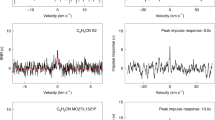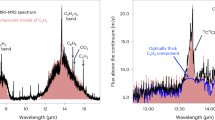Abstract
Much like six-membered rings, five-membered rings are ubiquitous in organic chemistry, frequently serving as the building blocks for larger molecules, including many of biochemical importance. From a combination of laboratory rotational spectroscopy and a sensitive spectral line survey in the radio band toward the starless cloud core TMC-1, we report the astronomical detection of 1-cyano-1,3-cyclopentadiene (1-cyano-CPD, c-C5H5CN), a highly polar, cyano derivative of cyclopentadiene. The derived abundance of 1-cyano-CPD is far greater than predicted from astrochemical models that well reproduce the abundance of many carbon chains. This finding implies that either an important production mechanism or a large reservoir of aromatic material may need to be considered. The apparent absence of its closely related isomer, 2-cyano-1,3-cyclopentadiene, may arise from that isomer’s lower stability or may be indicative of a more selective pathway for formation of the 1-cyano isomer, perhaps one starting from acyclic precursors. The absence of N-heterocycles such as pyrrole and pyridine is discussed in light of the astronomical finding of 1-cyano-CPD.
This is a preview of subscription content, access via your institution
Access options
Access Nature and 54 other Nature Portfolio journals
Get Nature+, our best-value online-access subscription
$29.99 / 30 days
cancel any time
Subscribe to this journal
Receive 12 digital issues and online access to articles
$119.00 per year
only $9.92 per issue
Buy this article
- Purchase on Springer Link
- Instant access to full article PDF
Prices may be subject to local taxes which are calculated during checkout



Similar content being viewed by others
Data availability
The datasets analysed during the current study are available in the Green Bank Telescope archive (https://archive.nrao.edu/archive/advquery.jsp). A user manual for their reduction and analysis is available as well (https://greenbankobservatory.org/science/gbt-observers/visitor-facilities-policies/data-reduction-gbt-using-idl/). The complete, reduced survey data in the X band are available as supplementary information in ref. 15. The individual portions of reduced spectra used in the analysis of the individual species presented here are available in the Harvard Dataverse archive26.
Code availability
All the codes used in the MCMC fitting and stacking analysis presented in this paper are open source and publicly available at https://github.com/ryanaloomis/TMC1_mcmc_fitting.
References
McGuire, B. A. et al. Detection of the aromatic molecule benzonitrile (c-C6H5CN) in the interstellar medium. Science 359, 202–205 (2018).
Lipkus, A. H. et al. Structural diversity of organic chemistry. A scaffold analysis of the CAS registry. J. Org. Chem. 73, 4443–4451 (2008).
Ruddigkeit, L., van Deursen, R., Blum, L. C. & Reymond, J.-L. Enumeration of 166 billion organic small molecules in the chemical universe database GDB-17. J. Chem. Inf. Model. 52, 2864–2875 (2012).
McGuire, B. A. 2018 census of interstellar, circumstellar, extragalactic, protoplanetary disk, and exoplanetary molecules. Astrophys. J. Suppl. Ser. 239, 17 (2018).
Laurie, V. W. Microwave spectrum and dipole moment of cyclopentadiene. J. Chem. Phys. 24, 635–636 (1956).
Damiani, D., Ferretti, L. & Gallinella, E. Structure of cyclopentadiene from microwave spectra of several deuterated species. Chem. Phys. Lett. 37, 265–269 (1976).
Turro, N. J. & Hammond, G. S. The photosensitited dimerization of cyclopentadiene. J. Am. Chem. Soc. 84, 2841–2842 (1962).
Werner, H. At least 60 years of ferrocene: the discovery and rediscovery of the sandwich complexes. Angew. Chem. Int. Ed. 51, 6052–6058 (2012).
Dalkílíç, E. & Daştan, A. Synthesis of cyclopentadiene derivatives by retro-Diels–Alder reaction of norbornadiene derivatives. Tetrahedron 71, 1966–1970 (2015).
Wentrup, C. & Crow, W. Structures of cyanocyclopentadienes and related compounds. Tetrahedron 26, 4375–4386 (1970).
McCarthy, M. C. et al. Exhaustive product analysis of three benzene discharges by microwave spectroscopy. J. Phys. Chem. A 124, 5170–5181 (2020).
Ford, R. G. & Seitzman, H. A. The microwave spectrum and dipole moment of 1-cyano-1,3-cyclopentadiene. J. Mol. Spectrosc. 69, 326–329 (1978).
Sakaizumi, T., Kikuchi, H., Ohashi, O. & Yamaguchi, I. The microwave spectra, dipole moments, and two isomers of cyclopentadiene-1-carbonitrile. Bull. Chem. Soc. Jpn. 60, 3903–3909 (1987).
Kaifu, N. et al. A 8.8–50 GHz complete spectral line survey toward TMC-1 I. Survey data. Publ. Astron. Soc. Jpn. 56, 69–173 (2004).
McGuire, B. A. et al. Early science from GOTHAM: project overview, methods, and the detection of interstellar propargyl cyanide (HCCCH2CN) in TMC-1. Astrophys. J. Lett. 900, L10 (2020).
Dobashi, K. et al. Spectral tomography for the line-of-sight structures of the Taurus Molecular Cloud 1. Astrophys. J. 864, 82 (2018).
Dobashi, K. et al. Discovery of CCS velocity-coherent substructures in the Taurus Molecular Cloud 1. Astrophys. J. 879, 88 (2019).
Simmie, J. M. & Somers, K. P. Benchmarking compound methods (CBS-QB3, CBS-APNO, G3, G4, W1BD) against the active thermochemical tables: a litmus test for cost-effective molecular formation enthalpies. J. Phys. Chem. A 119, 7235–7246 (2015).
Lee, K. L. K., McGuire, B. A. & McCarthy, M. C. Gas-phase synthetic pathways to benzene and benzonitrile: a combined microwave and thermochemical investigation. Phys. Chem. Chem. Phys. 21, 2946–2956 (2019).
Xue, C. et al. Detection of interstellar HC4NC and an investigation of isocyanopolyyne chemistry in TMC-1 conditions. Astrophys. J. Lett. 900, L9 (2020).
Shingledecker, C. N., Molpeceres, G., Rivilla, V. M., Majumdar, L. & Kaestner, J. Isomers in interstellar environments (I): the case of Z- and E-cyanomethanimine. Astrophys. J. (in the press).
Nelson, R. D. Jr, Lide, D. R. & Maryott, A. A. Selected Values of Electric Dipole Moments for Molecules in the Gas Phase National Standard Reference Data Series—National Bureau of Standards 10 (US Department of Commerce National Bureau of Standards, 1967).
Lee, K. L. K., McGuire, B., Burkhardt, A. & McCarthy, M. C. Interstellar aromatic chemistry: a combined laboratory, observational, and theoretical perspective. In Laboratory Astrophysics (IAU S350): from Observations to Interpretation (eds Salama, F. & Linnartz, H.) (Cambridge Univ. Press, in the press).
Turner, B. E. A molecular line survey of Sagittarius B2 and Orion-KL from 70 to 115 GHz. II—Analysis of the data. Astrophys. J. Suppl. Ser. 76, 617–686 (1991).
Gratier, P. et al. A new reference chemical composition for TMC-1. Astrophys. J. Suppl. Ser. 225, 1110 (2016).
GOTHAM Collaboration. Spectral stacking data for Phase 1 science release of GOTHAM. Harvard Dataverse V4 https://doi.org/10.7910/DVN/PG7BHO (2020).
Balucani, N. et al. Formation of nitriles in the interstellar medium via reactions of cyano radicals, CN(X 2Σ+), with unsaturated hydrocarbons. Astrophys. J. 545, 892–906 (2000).
Woods, P. M., Millar, T. J., Zijlstra, A. A. & Herbst, E. The synthesis of benzene in the proto-planetary nebula CRL 618. Astrophys. J. 574, L167–L170 (2002).
Cooke, I. R., Gupta, D., Messinger, J. P. & Sims, I. R. Benzonitrile as a proxy for benzene in the cold ISM: low temperature rate coefficients for CN + C6H6. Astrophys. J. Lett. 891, L41 (2020).
Zimmerman, P. M. Growing string method with interpolation and optimization in internal coordinates: method and examples. J. Chem. Phys. 138, 184102 (2013).
Zimmerman, P. M. Automated discovery of chemically reasonable elementary reaction steps. J. Comput. Chem. 34, 1385–1392 (2013).
Jafari, M. & Zimmerman, P. M. Reliable and efficient reaction path and transition state finding for surface reactions with the growing string method. J. Comput. Chem. 38, 645–658 (2017).
Bouwman, J., Bodi, A., Oomens, J. & Hemberger, P. On the formation of cyclopentadiene in the C3H5 + C2H2 reaction. Phys. Chem. Chem. Phys. 17, 20508–20514 (2015).
Shingledecker, C. N., Tennis, J., Gal, R. L. & Herbst, E. On cosmic-ray-driven grain chemistry in cold core models. Astrophys. J. 861, 20 (2018).
Shingledecker, C. N. & Herbst, E. A general method for the inclusion of radiation chemistry in astrochemical models. Phys. Chem. Chem. Phys. 20, 5359–5367 (2018).
Ruaud, M., Wakelam, V. & Hersant, F. Gas and grain chemical composition in cold cores as predicted by the Nautilus three-phase model. Mon. Not. R. Astron. Soc. 459, 3756–3767 (2016).
Wakelam, V. et al. The 2014 KIDA network for interstellar chemistry. Astrophys. J. Suppl. Ser. 217, 20 (2015).
Trevitt, A. J., Goulay, F., Taatjes, C. A., Osborn, D. L. & Leone, S. R. Reactions of the CN radical with benzene and toluene: product detection and low-temperature kinetics. J. Phys. Chem. A 114, 1749–1755 (2010).
Woon, D. E. & Herbst, E. Quantum predictions of the properties of known and postulated neutral interstellar molecules. Astrophys. J. Suppl. Ser. 185, 273–288 (2009).
Loomis, R. A. et al. Non-detection of HC11N towards TMC-1: constraining the chemistry of large carbon-chain molecules. Mon. Not. R. Astron. Soc. 463, 4175–4183 (2016).
Hincelin, U. et al. Oxygen depletion in dense molecular clouds: a clue to a low O2 abundance? Astron. Astrophys. 530, A61 (2011).
Acknowledgements
M.C.M. and K.L.K.L. acknowledge support from National Science Foundation (NSF) grant AST-1908576 and NASA grant 80NSSC18K0396. A.M.B. acknowledges support from the Smithsonian Institution as a Submillimeter Array Fellow. C.N.S. thanks the Alexander von Humboldt Stiftung/Foundation for their generous support, as well as V. Wakelam for use of the NAUTILUS v1.1 code. S.B.C. and M.A.C. were supported by the NASA Astrobiology Institute through the Goddard Center for Astrobiology. E.H. thanks the NSF for support through grant AST-1906489. C.X. is a Grote Reber Fellow, and support for this work was provided by the NSF through the Grote Reber Fellowship Program administered by Associated Universities, Inc./National Radio Astronomy Observatory and the Virginia Space Grant Consortium. Support for B.A.M. was provided by NASA through Hubble Fellowship grant HST-HF2-51396 awarded by the Space Telescope Science Institute, which is operated by the Association of Universities for Research in Astronomy, Inc., for NASA, under contract NAS5-26555. The National Radio Astronomy Observatory is a facility of the NSF operated under cooperative agreement by Associated Universities, Inc. The Green Bank Observatory is a facility of the NSF operated under cooperative agreement by Associated Universities, Inc.
Author information
Authors and Affiliations
Contributions
M.C.M. and K.L.K.L. performed the laboratory experiments and theoretical calculations and wrote the paper with the help of A.M.B. and C.N.S. A.M.B, B.A.M., A.J.R. and R.A.L. performed the astronomical observations and subsequent analysis. E.H. determined and/or estimated rate coefficients and is the originator of many of the chemical simulations. A.M.B. and C.N.S. contributed or undertook the astronomical modelling and simulations. E.R.W., M.A.C., S.B.C., S.K., C.X., B.A.M., A.J.R. and R.A.L. contributed to the design of the GOTHAM survey, and helped revise the manuscript.
Corresponding authors
Ethics declarations
Competing interests
The authors declare no competing interests.
Additional information
Publisher’s note Springer Nature remains neutral with regard to jurisdictional claims in published maps and institutional affiliations.
Extended data
Extended Data Fig. 1 Spectral data.
Total number of transitions of a given species within the range of the GOTHAM data, number of interfering lines, and total number included in MCMC fit.
Extended Data Fig. 2 Thermochemistry (0 K) for the reaction between CN radical and CPD.
The calculated has been performed at the G3//B3LYP level of theory, and energies in kJ/mol are given relative to the reactant asymptote. The reaction bifurcates as CN attacks CPD barrierlessly, forming a radical intermediate. Subsequent hydrogen atom loss yields 1-cyano- and 2-cyano-CPD.
Extended Data Fig. 3 Potential energy surface for the formation of CPD at 0 K.
Reaction energies are given relative to the product (CPD + H atom) asymptote. The red trace corresponds to reaction between propargyl radical (HCCCH2) and ethylene (H2C=CH2), and the blue trace represents gauche-butadiene (H2C(CH)2CH2) reacting with CH radical.
Supplementary information
Supplementary Information
Supplementary Tables 1–5, Figs. 1–6 and text.
Rights and permissions
About this article
Cite this article
McCarthy, M.C., Lee, K.L.K., Loomis, R.A. et al. Interstellar detection of the highly polar five-membered ring cyanocyclopentadiene. Nat Astron 5, 176–180 (2021). https://doi.org/10.1038/s41550-020-01213-y
Received:
Accepted:
Published:
Issue Date:
DOI: https://doi.org/10.1038/s41550-020-01213-y
This article is cited by
-
Carbon-chain chemistry in the interstellar medium
Astrophysics and Space Science (2024)
-
Five-membered ring compounds from the ortho-benzyne + methyl radical reaction under interstellar conditions
Nature Astronomy (2023)
-
Identification and characterization of a new ensemble of cometary organic molecules
Nature Communications (2022)
-
An investigation of spectral line stacking techniques and application to the detection of HC11N
Nature Astronomy (2021)
-
Ubiquitous aromatic carbon chemistry at the earliest stages of star formation
Nature Astronomy (2021)



